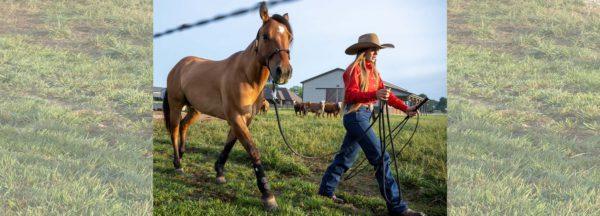Training Tip: Horse Locks Up His Feet and Won’t Lead

Question: When I ask my horse to walk off, say to start working or anything he doesn’t want to do, he plants his feet and refuses to move. I’ve tried pulling him along, turning to face him and letting him follow the feel of a loose rope, which only ever works for a couple of steps. Now I resort to a tap/slap on his girth with my hand or the end of the lead rope. – lovinhorses
Clinton’s Answer: Horses aren’t born knowing how to lead—you have to teach them how. Your horse is screaming to you that you need to start the Fundamentals groundwork exercises with him. Thirteen exercises make up the groundwork portion of the Fundamentals level of the Method, and careful thought was given to the order in which the exercises are laid out. Each exercise provides a foundation for all of the other exercises to build on.
The second-to-last exercise in the groundwork portion of the level is Leading Beside. Using this exercise, you’ll teach the horse to move beside you without pushing on you, dragging his feet or speeding ahead of you. The exercise teaches the horse to respect your space, pay close attention to you and take direction from you rather than following his own agenda. It’s especially good for horses like your gelding that drag their feet because it teaches them that as soon as they feel the halter pressure behind their ears, they should immediately come forward off of it rather than pull and lean against it.
To work on the exercise, put your horse in a halter and lead rope. You’ll need a Handy Stick. Remove the string from the stick and tie it halfway up the horse’s neck, between his throatlatch and the base of his neck. The string will act as a guideline—while working on the exercise, the string should stay level with your shoulder.
Position the horse beside a fence so that his right side is parallel to it, about 3 feet off of it. Hold the Handy Stick in your left hand as if you were shaking someone’s hand. Ask the horse to walk forward by leaning your entire body forward from you waist up. Then point straight ahead with whichever hand is holding the lead rope, making contact with the halter.
If the horse doesn’t immediately walk forward, swing the stick behind your body and tap the horse behind the drive line. Continue tapping, gradually increasing the pressure until the horse comes up beside you.
Walk forward at a brisk pace, keeping the string around the horse’s neck in line with your shoulders. Your hands should be down at your sides in a neutral position. If the string falls behind your shoulders, lean your upper body forward and stretch your hand that’s holding the lead rope forward to signal the horse to speed up and get back into position. If he doesn’t come off the point, use the stick to tap behind his drive line.
Continue practicing the exercise until the horse stays in position and you don’t have to correct him. You should practice the exercise on both sides of the horse’s body so that you can lead him from the left and the right.
Before attempting to teach your horse Leading Beside, you have to earn his respect. His planting his feet in the ground and refusing to move forward when he doesn’t want to do something is the equivalent of a kid throwing a fit when they don’t want to do what their parent tells them. Earn his respect and gain control of his feet in the Roundpenning Exercises in the Fundamentals Series. You’ll find once you start taking him through the Fundamentals level of the Method you’ll have very few problems with him.
Have a horsemanship question or looking for more training tips? Check out the No Worries Club.
